Red light therapy works by delivering specific wavelengths of light that penetrate your skin and reach deeper tissues, activating mitochondria to boost ATP production. This energizes cells, promotes healing, reduces inflammation, and enhances collagen growth for healthier skin. Clinical studies show it can improve skin health and relieve pain, but research is ongoing to optimize protocols. To discover how these mechanisms can benefit you, explore further insights below.
Key Takeaways
- Red light therapy stimulates mitochondria by activating cytochrome c oxidase, increasing ATP production for cellular repair and regeneration.
- Penetration depth depends on wavelength; 600-700 nm wavelengths reach deeper tissues, enhancing therapeutic effects.
- Clinical evidence shows red light reduces inflammation, accelerates wound healing, and alleviates pain through improved cellular function.
- Biological mechanisms involve gene expression modulation and enhanced mitochondrial activity, supporting tissue health and recovery.
- Ongoing research aims to optimize dosage, wavelengths, and application methods for broader medical and cosmetic benefits.
How Red Light Penetrates the Skin and Tissues
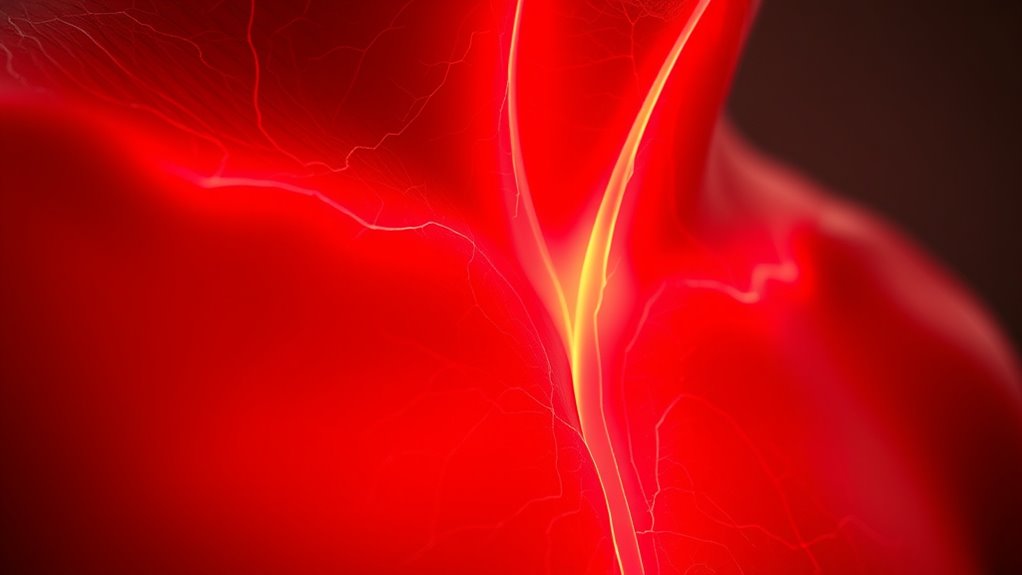
Red light penetrates the skin through a process called photobiomodulation, where specific wavelengths of red light are absorbed by cells. The effectiveness of this penetration depends on the skin depth, which varies based on your skin type and the wavelength used. Shorter wavelengths tend to be absorbed more superficially, while longer wavelengths can reach deeper tissues. Light wavelength plays a vital role in how far the light can travel beneath the surface, with wavelengths around 600-700 nanometers typically penetrating several millimeters. As you apply red light therapy, understanding these factors helps optimize treatment to target the desired tissue layers. By choosing the right wavelength, you maximize red light’s ability to reach deeper tissues without excessive absorption at the skin’s surface. Wavelength selection is crucial for enhancing the depth of penetration and achieving therapeutic benefits effectively. Additionally, advancements in light delivery techniques can improve how effectively red light reaches target tissues.
The Role of Mitochondria in Red Light Therapy

Your cells rely on mitochondria to produce energy, and red light therapy stimulates this process. Cytochrome c oxidase, a key enzyme in mitochondria, absorbs the light and boosts energy production. As a result, your cells can repair and regenerate more effectively. Additionally, this process is similar to how cells respond during cellular repair and recovery. The enhancement of mitochondrial function may also contribute to overall cell health and resilience. Recognizing that creative practice involves dedicated focus, incorporating red light therapy could potentially support better concentration and sustained effort in your creative endeavors, especially as it may influence biological energy production.
Mitochondrial Energy Boost
Mitochondria, often called the powerhouses of the cell, play a essential role in generating energy that fuels every biological process. When you’re exposed to red light therapy, it stimulates your mitochondria to produce more ATP, the energy currency of cells. This boost can improve skin pigmentation by promoting healthier cell function and regeneration. Increased energy also helps reduce pain by supporting tissue repair and decreasing inflammation. As your mitochondria become more efficient, your body can better manage cellular stress and recover faster. The enhanced mitochondrial activity not only benefits skin health but also amplifies pain relief, making red light therapy a promising approach for overall cellular revitalization. This process underscores how mitochondrial energy boosts are central to the therapy’s effectiveness. Additionally, these improvements are linked to the beneficial effects observed in studies on overall cellular health and function. Research also suggests that improving mitochondrial function can support cellular resilience against various stressors, further enhancing recovery and health outcomes. Moreover, understanding mitochondrial dynamics can help optimize treatment protocols for better results in cellular therapy.
Cytochrome C Oxidase Role
Cytochrome c oxidase, a key enzyme in the electron transport chain, plays a crucial role in how red light therapy stimulates cellular energy production. When exposed to red light, photons are absorbed by cytochrome c, boosting its activity. This enhances the electron transport process, leading to increased production of ATP, the cell’s energy currency. As a result, your cells function more efficiently, supporting healing and regeneration. The process of cellular energy production is fundamental to the therapeutic effects observed with red light therapy. Additionally, data-driven strategies can be utilized to optimize treatment protocols for better outcomes. Recognizing the importance of mitochondrial health can further enhance the effectiveness of red light therapy in clinical settings. Moreover, understanding mitochondrial function is essential for developing targeted therapies that maximize cellular benefits.
Cellular Repair Enhancement
Red light therapy enhances cellular repair by directly stimulating the mitochondria, the energy-producing organelles within your cells. This process activates specific therapeutic mechanisms that boost mitochondrial function, leading to increased production of ATP, the energy your cells need to repair and regenerate. Through cellular signaling, red light encourages mitochondria to become more efficient, reducing oxidative stress and supporting the synthesis of new proteins and cellular components. These improvements in mitochondrial activity accelerate tissue healing, reduce inflammation, and promote overall cellular health. Additionally, optimizing GMC tuning can further enhance cellular efficiency and recovery processes. By targeting the core of cellular energy production, red light therapy offers a powerful method to enhance your body’s natural repair processes. The result is improved recovery, crucial, and resilience at the cellular level. For optimal results, maintaining proper cellular metabolism is essential to support these processes effectively. Furthermore, supporting overall cognitive development through proper cellular function can contribute to better health outcomes. As research continues, understanding the role of mitochondria in health and disease highlights the importance of therapies that target cellular energy production.
Cellular Responses to Red Light Exposure
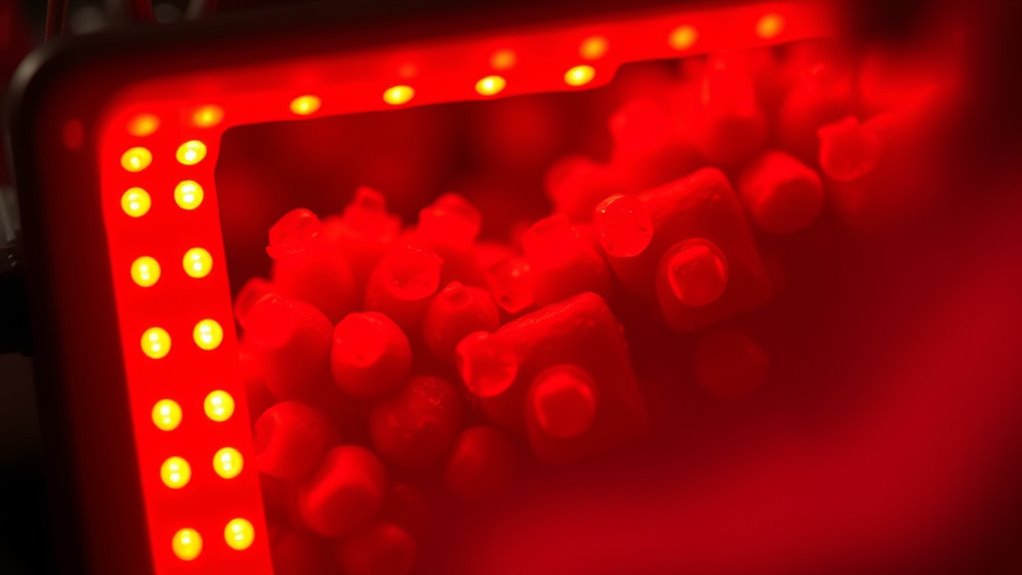
When your cells are exposed to red light, they respond quickly by activating their energy-producing processes. This happens through photoreceptor activation, where specific cellular molecules absorb the light and trigger internal signaling pathways. As a result, your cells increase mitochondrial activity, boosting ATP production, which provides energy for repair and maintenance. Red light exposure also influences gene expression modulation, turning on genes related to cell survival, growth, and repair. This rapid response enhances your cells’ ability to recover from damage and maintain ideal function. Understanding cellular development can help optimize treatment timing and effectiveness. By stimulating these cellular mechanisms, red light therapy helps support overall tissue health. The activation of photoreceptors and modulation of gene expression form the foundation for many of the therapeutic benefits associated with red light exposure.
Effects on Inflammation and Circulation

Red light therapy can markedly reduce inflammation and improve circulation by promoting cellular repair and blood flow. It helps lower oxidative stress, which damages cells and worsens inflammation, while supporting immune modulation to balance immune responses. This dual action enhances tissue healing and reduces swelling. Improved circulation delivers oxygen and nutrients more efficiently, accelerating recovery. Consider the following insights:
| Effect | Mechanism | Benefit |
|---|---|---|
| Reduces inflammation | Decreases oxidative stress | Less pain and swelling |
| Enhances blood flow | Promotes cellular repair | Faster healing |
| Supports immune modulation | Balances immune activity | Better tissue recovery |
Impact on Collagen Production and Skin Health
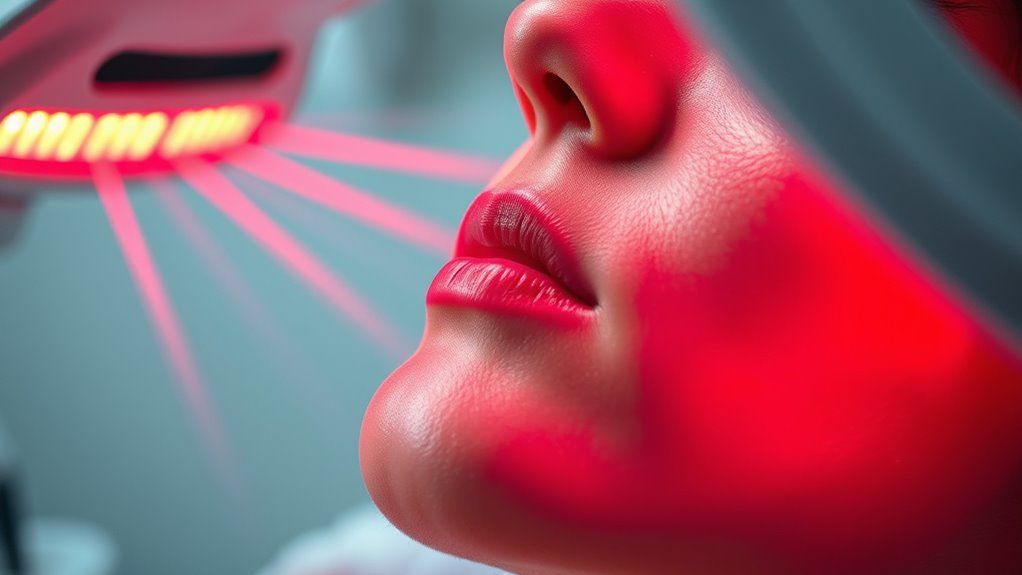
Have you ever wondered how light therapy can enhance your skin’s appearance? Red light therapy stimulates collagen synthesis, a key process that supports skin structure. When exposed to specific wavelengths, your skin cells increase production of collagen, which helps reduce fine lines and wrinkles. This increase in collagen also improves skin elasticity, making your skin feel firmer and more youthful. As a result, you notice a smoother, more radiant complexion. Unlike invasive procedures, red light therapy offers a non-invasive way to support your skin’s health over time. Regular treatments can strengthen your skin’s foundation, promoting a healthier, more resilient look. By encouraging natural collagen production, red light therapy helps you achieve better skin quality without harsh chemicals or surgery. Additionally, durable materials suited for kitchen use ensure that your cabinetry remains functional and attractive over time. Moreover, understanding the mechanisms of light therapy can help you make informed decisions about its use for skin health. Exploring specific wavelengths can further optimize your treatment outcomes for skin rejuvenation.
Evidence From Clinical Studies and Trials
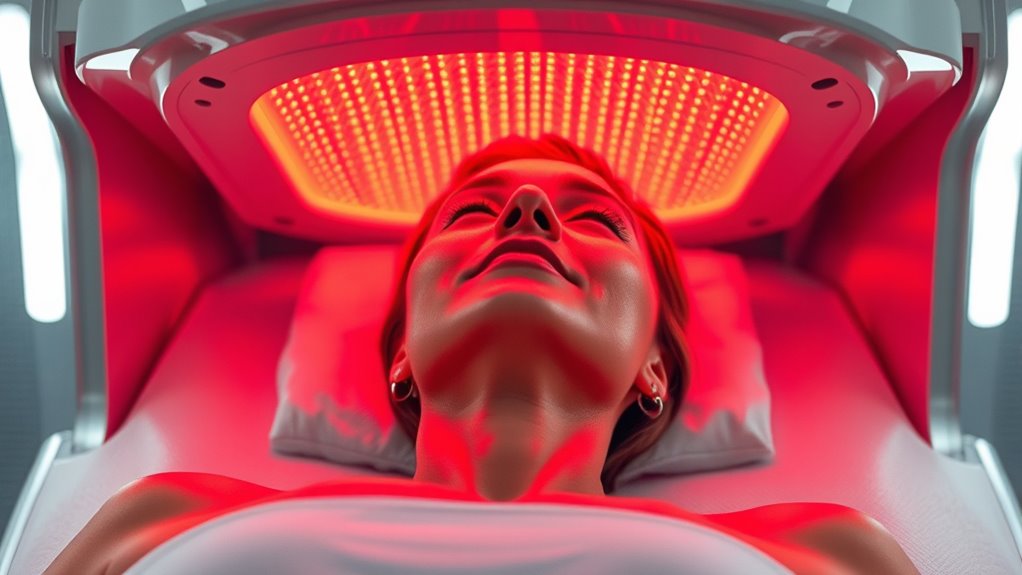
You can find solid evidence supporting red light therapy’s effectiveness in clinical studies. Randomized controlled trials have demonstrated significant improvements in skin healing and pain reduction. These findings suggest that red light therapy has real potential, backed by rigorous scientific research. Additionally, ongoing research continues to explore various application methods and their impact on different health conditions. As the body of evidence grows, researchers are also examining long-term effects and optimal treatment protocols to maximize benefits.
Clinical Efficacy Data
Numerous clinical studies have investigated the therapeutic potential of red light therapy, providing valuable evidence of its efficacy. These studies highlight the importance of dosage refinement to achieve consistent results across different conditions. Researchers have identified ideal wavelengths, intensities, and treatment durations that maximize benefits while minimizing risks. Importantly, many trials emphasize the long term safety of red light therapy, showing minimal adverse effects even with repeated use over extended periods. This growing body of clinical data supports its use for skin rejuvenation, pain relief, and other health benefits. While individual responses may vary, the overall evidence suggests that, with proper dosing, red light therapy is a safe and effective treatment option backed by scientific research.
Randomized Controlled Trials
Randomized controlled trials (RCTs) provide the most rigorous evidence for red light therapy’s effectiveness. They help distinguish real benefits from placebo effects, which can influence patient perceptions. In these studies, you’re less likely to be misled by expectations, as both you and researchers are blinded to treatment groups. RCTs also emphasize patient compliance, ensuring you follow treatment protocols accurately, which is vital for reliable results. When well-designed, these trials show whether red light therapy genuinely improves conditions like pain, skin health, or inflammation. By controlling variables and comparing against placebo groups, RCTs deliver solid evidence that can inform your decision to try red light therapy confidently. Overall, they are essential for validating the clinical use of this treatment.
Limitations and Gaps in Current Research

Although red light therapy shows promise, current research faces significant limitations that hinder definitive conclusions. Methodological challenges, such as small sample sizes, inconsistent treatment protocols, and lack of standardized dosages, make it difficult to compare results across studies. Additionally, many studies focus on short-term effects, leaving long-term safety and efficacy unclear. This gap raises concerns about potential risks with prolonged or repeated use, which remain underexplored. Without rigorous, large-scale trials, it’s hard to determine ideal treatment parameters or fully understand possible adverse effects. These limitations emphasize the need for well-designed research to establish reliable evidence. Until then, caution is advised when interpreting existing findings and considering red light therapy as a treatment option.
Future Directions and Potential Applications
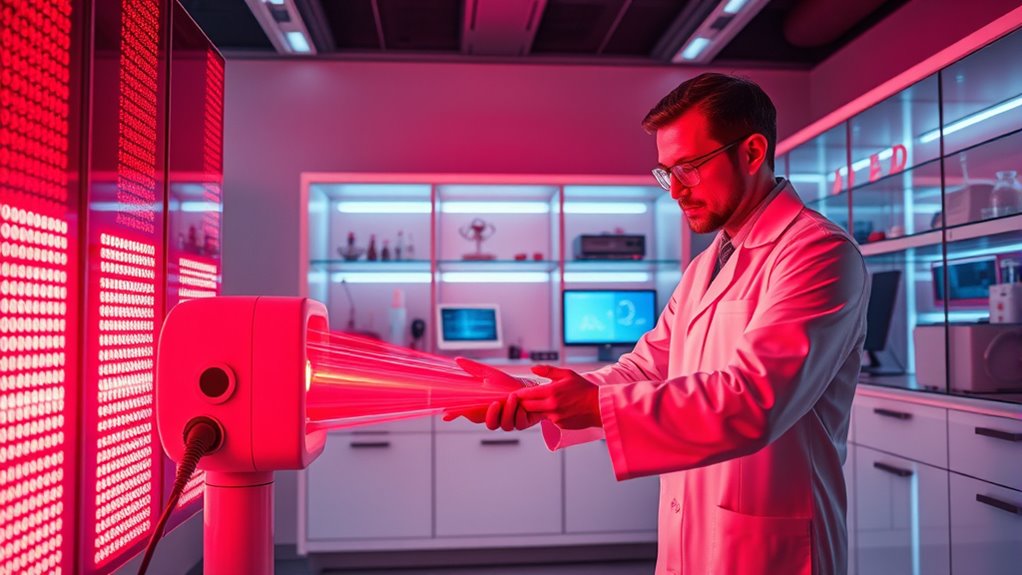
Looking ahead, red light therapy holds significant potential for a wide range of medical and cosmetic applications as research progresses. You can expect innovative device development to enhance treatment effectiveness, making devices safer, more portable, and user-friendly. Advances will likely enable personalized therapy protocols tailored to individual needs, optimizing outcomes for conditions like skin rejuvenation, pain management, and wound healing. As scientists better understand the mechanisms involved, you may see targeted wavelengths and dosages designed for specific treatments. These innovations could expand access and improve results across clinical and at-home settings. The ongoing evolution of technology and research promises to release new possibilities, positioning red light therapy as a versatile tool for improving health and appearance in the future.
Frequently Asked Questions
Are There Any Side Effects Associated With Red Light Therapy?
You might wonder if red light therapy has side effects. Generally, it’s safe, but some people experience skin sensitivity or minor irritation, especially if they have sensitive skin. Eye safety is also important; you should avoid direct exposure to your eyes or wear protective goggles. While serious side effects are rare, following safety guidelines helps minimize risks and guarantees you get the most benefit from this therapy.
How Long Does It Take to See Results From Red Light Therapy?
While patience tests your resolve, red light therapy offers hope for visible improvements. Typically, you might start noticing changes after 2 to 4 weeks of consistent treatment, but this varies based on individual factors. The treatment duration influences how quickly you see results, so sticking with the routine is key. Remember, some improvements may appear gradually, emphasizing the importance of ongoing commitment for ideal benefits.
Can Red Light Therapy Be Effective for Chronic Pain Relief?
You might find red light therapy effective for chronic pain relief, especially in managing pain and reducing inflammation. It works by promoting cellular repair and decreasing inflammation, which can alleviate discomfort over time. Many users report improvements after several sessions, though results vary. For best pain management, consistency is key, and combining red light therapy with other treatments can enhance overall effectiveness.
Is Red Light Therapy Safe for All Skin Types and Tones?
You wonder if red light therapy is safe for all skin types and tones. Generally, it’s considered safe, but skin tone suitability varies. People with darker skin tones may experience different effects or need adjustments due to increased melanin. Safety considerations include avoiding overexposure and consulting a healthcare professional if you have skin conditions. Always follow device instructions to guarantee safe use tailored to your skin tone.
What Are the Differences Between Red and Near-Infrared Light Therapies?
Red and near-infrared light therapies differ mainly in wavelength, affecting tissue penetration. Red light typically has a wavelength around 620-750 nm, penetrating shallow layers like skin. Near-infrared light, with wavelengths around 780-1100 nm, penetrates deeper into tissues. This difference influences their uses, with near-infrared being more suited for deeper tissue healing, while red light focuses on surface skin benefits.
Conclusion
Imagine red light as a gentle wave, reaching deep into your skin like whispers of energy. It awakens your mitochondria, fueling cellular renewal and reducing inflammation. This process can boost circulation, enhance skin elasticity, and promote healing. While promising, it is crucial to remember that research is ongoing. Think of red light therapy as a potential key—unlocking healthier skin and vitality—yet, like all keys, it’s only as effective as the lock it fits.









